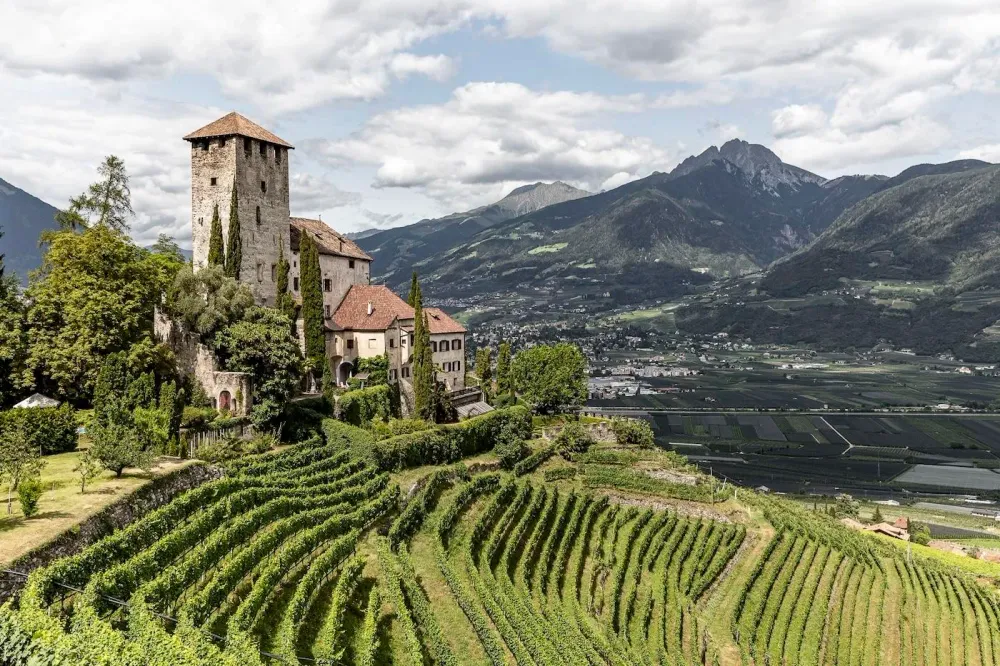Campania Now Confidently At The Heart Of Italy’s Viticultural Excitement
From volcanic reds to fragrant coastal whites, Campania’s wine scene deserves the spotlight as much as anywhere as it showcases its role as Italy’s most exciting wine region.

To call Campania the most exciting wine region in Italy is a big statement. Depending on your metrics however, it may well be true. Appreciated in equal measure for both its red and white wines, a new generation of ownership is not only leveraging the latest wine making science, it is doing so to advance the reputations of traditional grape varieties - in turn strengthening the region’s contribution to the world of wine.
Campania has four DOCG appellations, a number of ambitious DOC and IGT territories and at least a dozen grapes capable of producing quality mono-varietal wines. In just two decades, Fiano and Greco have become part of the Italian wine establishment, while Falanghina is staking a strong claim to join them. Aglianico’s reputation, which I’ve written about at length here, is unquestionable when it comes to producing fine red wines, especially in Taurasi. The red-skinned Piedirosso may never offer as much complexity, but it is certainly capable of producing good terroir influenced wines. There are more though. Coastal varieties such as Biancolella is showing lots of promise, while the likes of Pallagrello (red and white) and Casavecchia grown in the north of the region are attracting justifiable recognition.
Of the region’s 24,000 hectares of vineyard, 85% are planted on hillsides on mountainous slopes. Only around the 15% are planted on the plains, often considered inferior terrain for growing good wine grapes. That is to say, viticulture here is not set up for bulk production; rather, a majority of boutique family-owned wineries must develop their commercial strategies with a quality over quantity approach. The results are impressive.
Behind the industry’s development sits a change in ethos, both in the vineyard and in attitudes toward the market. The USA remains a critical outlet for exporters across southern Italy, even during this tariff induced trading challenge, but the gradual realisation that chasing trends and matching the perceived tastes of generic consumers is ultimately counter productive. Fuelling the current renaissance then is a collective investment in authenticity.
The international success of Fiano di Avellino (DOCG) and Greco di Tufo (DOCG) has now rendered them a necessary part of any Italian wine enthusiast's cellar, but it wasn't long ago that these were fringe names. The leg work and resulting visibility of brands such as Mastroberardino, Terredora, and Feudo di San Gregorio have given prominence and created global awareness of these varieties. Now, as initial curiosity inspires the enthusiast to dig deeper into the territory, less corporate producers and wines are standing out as strong ambassadors for the region.

Fiano is an indigenous grape to Campania, but its quality has inspired plantings in both Sicily, Puglia, the U.S. and beyond. Around the town of Avellino, it gives a wine of intense aroma, with seductive perfumes of tropical fruit and honey. With age it will take on tertiary aromas of roasted nuts, spice and smoke. Such a transformation can be found in the wines of Roberto Di Meo, whose ‘Alessandra’ cuvee is always fresh and exciting a decade on from the vintage.
Other names provide strong competition. Tenuta Scuotto, Colli di Lapio Romano Cleli, and Joaquin make excellent wines, while Donnachiara and Villa Raiano are also worth looking for. The appellation is ripe for further study. Altitudes range from 400-700m and contain varying quantities of volcanic tuff and calcareous clays. As producers focus more on individual parcels, we can expect deeper discussion of the nuances associated with villages such as Montefalcione, Lapio and Montefredane.

A similar anecdote can be told about Greco. Small producers are reaping the benefits of greater familiarity with the variety. Ferrante di Somma leads the way when it comes to expressing his Cantine di Marzo estate’s single vineyard characteristics. Vigna Ortale, Vigna Laure, and Vigna Serrone all show subtly different interpretations of terroir. Vintage variation shifts my preferences, but the combination of knife-edge acidity, tropical fruit, and herbal complexity makes these worthy additions to the cellar.
Vesuvius of course is the most recognisable geological landmark in the region. Its complex volcanic soils make for fascinating wines, and now that more producers are seeking to express this (rather than new barrique) there is plenty to be excited about. Ciro Giordano has shown many the way on these volatile slopes with an investment into the white grape Catalanesca. His winery, Cantine Olivella, releases a wine called Katà under the IGP appellation Catalanesca del Monte Somma. Heady and fragrant, it oozes lemon and lime alongside distinctive fern and juniper. It’s a fascinating wine and hopefully inspiration for others.
The same approach has been applied to Caprettone, another of the territory’s white grapes. The farmer’s tendency to pursue high yields obscured the delicate pleasantness this grape gives when handled carefully. It may oxidise quickly, but with some diligence while harvesting and again in the cellar can pay off. The result, as demonstrated by at least half a dozen wineries now, can be surprisingly good. The variety is most likely to be found as part of the traditional Lacryma Christi, within which it must represent a minimum of 80%.

Elsewhere on Vesuvius, Paolo Sorrentino’s organically cultivated vineyard catch the eye. They have even helped volcanologists precisely date and time the eruption that obliterated Pompei in October 79AD by studying the layers of sub soil. Located in the village of Boscotrecase, the estate offers one of the most accessible Eno-tourism experiences in the area. The wines are good too, the most intriguing of which is a Vesuvius DOC ‘Lacryma Christi’ white by the name of ‘Vigna Lapillo’.
These volcanic wines can age too. Cleaner cellars and suitable storage conditions are reminding us that varieties such as Caprettone and Coda di Volpe have a backbone of acidity that facilities positive evolution. The gradual accumulation of older vintages on the market has lead to a realisation that these fairly inexpensive wines are extremely underpriced. Villa Dora, for example, presents ‘Vigna del Vulcano’, another Lacryma Christi white wine and demonstrates impressive age worthiness. Produced from vines dating back to 1950, the 2002, 2005 and 2015 are stilling thriving. The company is currently collaborating with Fabio Mecca, whose consulting extends across Southern Italy and is behind a number of excellent wines.
It’s not only Vesuvius housing interesting winemaking projects. There are cool things happening all around the city of Naples. The Campi Flegrei, which you can also read about here, infuses its wines with all the hallmarks of the local environment. Volcanic soils are a given, but less discussed here is the influence of altitudes and proximity to the sea. Some wines are made from vineyards a stone’s throw from the water. La Sibilla and Cantina del Mare both produce wines with abundant salinity, and in the whites wines (from Falanghina Flegria), one senses the surrounding landscape acutely. Meanwhile, higher up, growers such as Raffaele Moccia (Agnanum) have more perfumes freshness in their wines.
In Grangnano, a small town to the South East of the city known for the production of pasta, Salvatore Martusciello and his wife Gilda are preserving another local in the production of sparking red wines. Produced from eight different local grapes, their ‘Ottouve’ is a simple but popular choice and its reputation is extending beyond the easy nearby tourism markets. Having been instrumental in the creation of the DOC, the family remains the only producer here to utilise all eight of the local grapes, including the obscure Sciascinoso, Suppezza, Castagnara, Olivella, and Sauca.

Viticulture on the nearby Amalfi coast and adjacent islands has never been easy. Costs are high, logistics are tricky, and simply put, there isn’t much land from which to develop the scale usually needed for commercial wineries. That being said, the latest generation of wine entrepreneurs have set their aspirations higher than supplying the local market of tourists. In the pursuit of higher quality (and higher prices), we now have excellent wines being made from grapes that are indigenous to the area between Naples and Salerno.
The standout name is Marisa Cuomo, whose increasingly famous terraced vineyards are intermingled with citrus tree groves and overlook the picturesque blue Tyrrhenian Sea below. These wines are now a mainstay on the lists of top restaurants around Milan, London and New York. The whites are produced with a blend of the little known Biancolella, Ginestra and Fenile. The reds from Aglianico and Piedirosso are also excellent.
Across the water, on the island of Ischia, there are two exciting names to look out for. Vini d’Ambra has been the reference here for a long time, but the white wines, made from Biancolella seem to get better and better, and as such are in greater demand from further away. There is a new name in town too. Antonio Mazzella’s crisp, mineral-laden wines are excellent, and with such low production are sure to be bought up by those in the know.

Another intriguing aspect of Campania’s viticultural depth at the moment is the area known loosely as Alta Campania. At least two grape varieties are revelling in the benefits of rejuvenation in the countryside north of Caserta. The rolling hills near the village of Pontelatone are quickly re-establishing their affinity with the red Casavecchia grape, and the white Pallagrello Bianco. The leading ambassador is Alois, who produces the most refined and complex expressions of both.
‘Morrone’, the estate’s flagship Pallagrello Bianco is positively Burgundian in style. A gentle agitation of the lees gives a creamy texture that enriches the variety’s predisposition to yellow orchard fruit and sharp acidity. The ‘Trebulanum’ Casavecchia Riserva, which carries a DOC (Casavecchia di Pontelatone) is just as exciting, and a fantastic example of what the grape can do when planted in the right place and handled with care. I’m a huge fan of its velvety, plush purple fruit and sturdy tannic grip.
I could go on and on. Sannio, is a great source of concentrated fruit-forward wines, especially from Falanghina Beneventana, but to describe them as such obfuscates the complexity of terroir and diversity. Cilento, south of Salerno has abundant space and will surely reveal a number of outstanding wines over the coming years. San Salvatore and Luigi Maffini’s wines are making that claim easy to make. For now, Paestum, with its Ancient Greek heritage provides a very marketable backdrop, but the wider area is proving itself suited to both red and white grapes.
Just how good are the wines you ask? Across the fine wine markets of the world collector capital has barely touched Campania so far. Matching the prestige of Piedmont and Tuscany will require another step up, but the trajectory is clear. For sheer breadth and diversity of both terroir and native varieties, no Italian region feels more engaging, or more exciting, right now.
Author

Wine writer, merchant, entrepreneur and creative strategist. I love sharing my passion for wine with the world.



